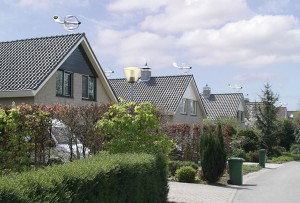Will wind energy work for me?
Wind energy works well on properties with a good wind resource. The Wind Energy Program provides wind resource maps that show average wind energy across each state. These maps provide a good overview of your state’s wind resources. However, wind can vary due to your locations physical characteristics which may include trees, hills and buildings. An experienced renewable energy contractor can perform a more detailed wind assessment to accurately define, measure, and forecast available wind resources at your location.
How much energy will a wind turbine generate?
The amount of energy produced by a wind turbine is dependent on its size and the speed of the wind. Residential wind turbines typically have a generation capacity of 400 watts to 100 kilowatts. If a 10 Kilowatt turbine is installed in an area with 12mph winds, it can produce an estimated 10,000 kWh per year, enough to power an average household for a year. Your renewable energy contractor can determine the size of turbine you require by estimating the amount of energy you need against the wind energy production you can expect at your location.
What zoning and permit issues will affect construction of a wind turbine?
Zoning laws control whether or not you can install a wind turbine at your location and may restrict its height although a variance may be obtained. Generally, zoning for wind turbines is easier in rural areas than in urban and suburban locations. Check your local zoning laws or ask your renewable energy contractor for help. Building and electrical permits can also be obtained by your contractor to ensure the structural and electrical safety of your turbine.
Where should I build a wind turbine?
Wind turbines are best placed in open plains or hilltops using towers to provide access to strong, prevailing winds. The bottom of the turbine blade should be a minimum of 30 feet above anything within 300 – 500 feet of the turbine. You’ll want to take into consideration any obstacles that may hinder the speed and force of wind flow including buildings and the present and future height of trees. The higher the turbine is, the more wind energy can be harnessed. Your renewable energy technician can help determine the best place for your turbine.
Do wind turbines produce any noise?
Today’s wind turbines are made with slender, aerodynamic blade tips that create little noise. Since background noises – traffic, rain, wind blowing through the trees – are very similar to the low inaudible sound of a wind turbine, it is difficult to recognize its sound in the environment.
Can I connect my wind energy system to the utility grid?
Wind energy systems can be grid-tied or connected to the local electrical grid. A grid-tied system allows you to pull electricity from the utility grid when your wind turbine is not producing power. When the wind system produces more power than your house needs, the excess is sent back to the utility grid. This is called net metering. You can receive credit for your excess energy which can then be applied to the electricity you get from the utility company when your energy usage exceeds your wind energy output. Using net metering can greatly reduce or even eliminate your electric bill.
What is a hybrid wind energy system?
Hybrid wind energy systems can provide reliable off-grid power for your home by combining wind and solar photovoltaic technologies. The varying peak operating times for wind and solar PV make hybrid systems more likely to produce power when you need it. At times when wind speeds are low during summer months, the sun shines the longest. And when less sunlight is available during winter months and at night, winds tend to be stronger. When neither the wind nor solar are producing energy, hybrid systems receive power through batteries or a generator.
How long do wind energy turbines last?
Wind energy turbines last approximately 20 to 25 years with regular maintenance.
Do wind turbines affect birds?
It has been found that wind turbines and wildlife are coexisting successfully. Wind energy’s overall impact on birds is extremely low compared to other causes such as utility lines, windows, buildings, pesticides, vehicles and cats. A more notable threat to birds comes from climate change and the loss of habitat worsened by the extraction and use of fossil fuels.
What incentives are available for wind energy?
DSIREusa.org can give you up-to-date information on incentives and policies that support the use of renewable energy. Federal tax credits and state incentives will significantly reduce the cost of your wind energy system.
